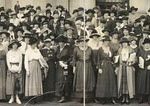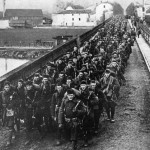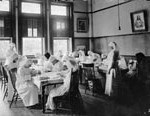
Volunteers at St. Elizabeths Hospital who Worked With Shell Shocked Vets, courtesy George Washington University
Dr. Hummer faced other difficulties associated with the war effort (see last post), particularly a troublesome personnel shortage. He told the commissioner of Indian Affairs that “it is extremely difficult to fill the existing vacancies and I am compelled to keep two or three employees who should be separated.” Since Hummer was typically just fine with a bare-bones staff, his situation at this point was dire; in August, 1918, he had only one male and one female attendant on staff (he should have had three of each). Hummer suggested an increase in pay as a possible solution to his problem, to $40/month with board and lodging for male attendants, and $35/month with board and lodging for females.
A project near and dear to Hummer’s heart also gave way to the war effort: the Indian Office denied his request for an epileptic cottage. This was partly because the asylum still had some vacancies and didn’t seem to need additional rooms. More importantly, as the assistant commissioner of Indian Affairs pointed out, the administration was already in the middle of a huge building program that “will of necessity withdraw carpenters from every section of the country.” Hummer may have been able to counter this with an offer by locals to help with construction, but even he could not argue with E. B. Meritt’s second consideration: there was a need for economy elsewhere in the expenditure of public funds “in order to more successfully prosecute the war.”
Hummer had perhaps anticipated this emphasis on war concerns when he made the following suggestion: “It is possible that the present war will necessitate the construction of another building at this place to care for the insane Indian soldiers or sailors, provided your Office deems this proper.” One way or another, the superintendent wanted additional buildings and patients.
______________________________________________________________________________________

